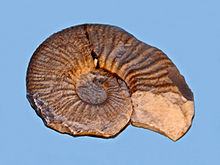| Pseudothurmannia Temporal range: Cretaceous, [1]
| |
|---|---|

| |
| Fossil shells of Pseudothurmannia species from Alpes-de-Haute-Provence, on display at Galerie de paléontologie et d'anatomie comparée in Paris | |
| Scientific classification | |
| Domain: | Eukaryota |
| Kingdom: | Animalia |
| Phylum: | Mollusca |
| Class: | Cephalopoda |
| Subclass: | †Ammonoidea |
| Order: | †Ammonitida |
| Suborder: | †Ancyloceratina |
| Family: | †Crioceratitidae |
| Genus: | †Pseudothurmannia Spath, 1923 |
| Synonyms | |
| |
Pseudothurmannia is a genus of extinct cephalopods belonging to the subclass Ammonoidea and included in the family Crioceratitidae of the ammonitid superfamily Ancylocerataceae. These fast-moving nektonic carnivores [1] lived in the Cretaceous period, from Hauterivian age to Barremian age.[2]